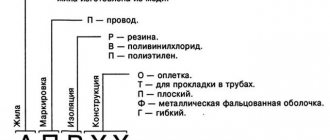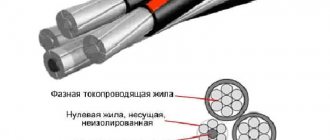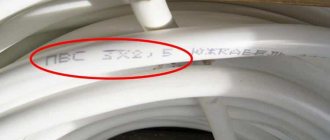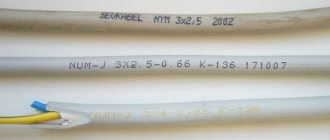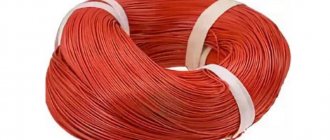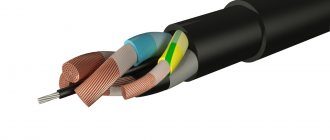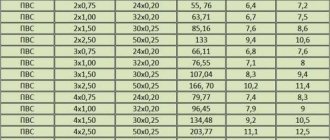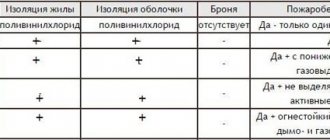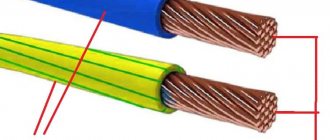The need for this material arises when it is necessary to install a new, or repair an existing, lighting or power connection network. Rigidity and geometric shape are convenient for stationary installation. Allows convenient connection of consumers with supply voltages up to 450 volts AC. If it is necessary to use it on direct current, the rated voltage is limited to 1 kV.
The article will introduce you to the main properties, parameters, conditions of use.
Features of decoding markings
Clearly marking the cable with letters and numbers makes it easy to work with. Marking is carried out according to the following features:
- To determine what the current-carrying part is made of, you should pay attention to the markings. If the letter A is indicated, then the core is made of aluminum. If the letter is missing, then the material is copper.
- If the marking consists of two letters, the first of which is P, then the letter indicates that it is a wire, and the second letter indicates the type, for example, flat.
- The letter designation is also used to indicate the shell material. B – polyvinyl chloride.
- The number indicates the number of cores and cross-section.
- The maximum possible voltage is indicated.
Taking these features into account, the marking PPV 2x4-380 stands for flat wire, two-core, core cross-section 4 mm2, with a permissible voltage of 380 Volts.
How to choose the right PPV cable
The first step is to decide from what composition to choose the cores.
Most electricians prefer copper conductors. The main advantage is that copper consumes less aluminum and also has a longer service life.
Important! Copper products will be more expensive, but they fully pay for themselves with their safety.
You can purchase wires of mixed types, made of copper and aluminum. But then, you need to combine them using a terminal block.
Terminal blocks for combining
If the wires come into contact with each other for a long time, they will quickly oxidize and their resistance will increase. Because of this, the cable quickly heats up and fails. In the worst case, contact may result in a fire at that point.
You might be interested in this: Connecting cables with a coupling
Next, the wire is selected for flexibility and rigidity.
A rigid product mainly consists of one core, and a flexible one consists of many.
Important! The greater the number of wires inside the cable and the smaller each wire, the softer the product will be.
Flexibility can be divided into 7 categories, single-core is category 1, and stranded is category 7.
Where is it used?
PPV cable is suitable for installation of electrical wiring and power systems. Suitable for use in networks with an alternating voltage of 450 Volts and a frequency of up to 400 Hertz. If direct current, then PPV is used at voltages up to 1000 Volts.
The scope of application is determined by the properties of the PPV shell material. The product is suitable for stationary and non-flexible installation. It is recommended to place PPV in pipes and channels of building structures. The scope of application is wide, even at hazardous chemical production facilities. The scope of application can be divided into:
- Electrical wiring outside in enclosed spaces.
- Residential, non-residential and industrial buildings.
- Communication systems.
Machine tools, units, lighting devices, electrical installations - it doesn’t matter what, but PPV is used for connection.
How to check the wire before purchasing
Before purchasing, you need to test the quality of wired products. First you need to ask the seller for a copy of the factory certificate of conformity. Verification does not require special knowledge or skills. The tools you need are a caliper and an electrical tester:
- The data on the product of the certificate, the factory tag on the coil, must completely match the markings on the wire sheath;
- Using a caliper or micrometer, measure the geometric dimensions of the wire, the thickness of the insulation, and the dimensions of the dividing tape. Measurements may be less than 0.05 mm;
- The diameter of the core is checked, having previously specified it from the cross-sectional value. An understatement of more than 5% is not allowed;
- On the cross section of the wire, a pure copper color should be visible without dark or light spots or inhomogeneities;
- High-quality copper springs weakly when bent. PVC is separated from the metal easily;
- Using a lighter or match, check the insulation for the spread of fire. The flame may slightly melt and wrinkle the insulation, but it should not catch fire.
- The tester checks the absence of wire breaks in the selected piece.
A defective or falsified wire can threaten life and lead to large material losses.
Specifications
A feature of any cable is the time during which the wire is operated at a stable voltage with a certain load in the network. The PPV is selected taking into account the cross-section that corresponds to the load:
- at 1.5 mm 18 Amperes, and a three-core cable - 15 Amperes;
- at 2.5 mm - 25 Amperes, three-wire - 21 Amperes;
- at 4 mm - 32 Amperes, three-wire - 27 Amperes.
It is strictly forbidden to exceed the recommended current load on the wire.
The PVC sheath does not burn, but high temperatures destroy the electrical insulating qualities, which affects its integrity and leads to short-circuiting of current-carrying conductors. According to the characteristics of PPV, it is resistant to moisture, elevated temperatures, steam and condensate. Such features make it superior to other products. Mold, mechanical stress, fungus - all this does not affect such a cable. The product is produced in skeins of 100 meters.
When choosing a PPV, the cross-section and characteristics of the product are taken into account. According to the cross-section, the load indicator on the PPV brand wire is determined. In networks for a three-wire conductor, a load of 27 Amperes is allowed.
Polyvinyl chloride is an insulation material that is characterized by strength. The use of a special component allows you to repel rodents from the wire. This type of insulation is self-extinguishing.
Twin-core
It is found in old buildings, country houses, garages, where it is used to design simple lighting networks. When using a two-wire model, a load of 32 Amps is allowed.
Three-core
When operating three-phase networks with a voltage of 380V, it is recommended to use a cable with three cores.
This option is also used for a conventional building with single-phase alternating current, but only there must be a ground loop. Modern houses provide a similar design. During connection, the outermost conductors are “phase” and “zero”, while the middle one is the grounding tap. Three-core PPV is provided by lighting systems with a connection via two lines, for example, a chandelier with several lamps.
Advantages and disadvantages
When using PPV for hidden wiring, you get several undoubted advantages:
- A wire located in a concrete or brick base and hidden under a layer of plaster or putty is characterized by increased fire safety compared to a cable laid using the open method. Everything is explained by the lack of air.
- The wire is protected from touch and accidental mechanical damage.
- Hidden wiring allows you to increase the service life of the cable, since the impact of negative environmental factors is eliminated.
- The wire is hidden, so it does not spoil the appearance and does not interfere with the formation of the interior of the room.
However, it also has its drawbacks:
- If errors are made during cable installation, it will be necessary to open the entire section of the route where the product was laid. As a result, you will damage the wall and require repeated repairs.
- Increasing wires using the twisting method leads to an increase in resistance and the appearance of sparks, especially if powerful devices are connected. Because of this, the released thermal energy increases, which can lead to melting or short-circuiting and complete loss of power to the circuit.
- If you need to move an outlet or switch, you will encounter increased labor intensity due to the need to organize additional channels.
- Difficulties that arise when searching for wires or when replacing old wiring with new ones. You will have to crumble walls and partitions.
PPV wire is actively used in both household and industrial areas. You can safely use the products to connect lighting systems and powerful electrical appliances. The main advantages are related to the versatility, practicality and low cost of the product.
Features of operation
Taking into account the operating features, it will be possible to extend the service life of the product. The temperature at which uninterrupted operation of the cable is allowed is 700C. According to electrical safety requirements, at an ambient temperature of 200C, the insulation resistance must be at least 1 MOhm.
Main characteristics of PPV:
- operation at low temperatures reaching -500C;
- Can be used at 100% ambient humidity.
The laying of such a wire is carried out under certain conditions: at temperatures down to -150C, and the bending radius should not exceed its diameter by 10 times.
Cable storage and transportation conditions
For any cable products, you must follow a number of rules for storage and transportation. Store wires only in a dry room with low humidity. Otherwise, mold or mildew may form on the product. It is advisable to make sure that there are no rodents in the warehouse that could damage the insulating layer. Storage is allowed at temperatures from 15 to 25 degrees. It is allowed to place cable reels outdoors, but away from direct sunlight.
Important! Cable drums must not be placed on their sides.
Service life and manufacturers
To maintain the technical characteristics of the product, it is important to adhere to the recommendations for use, as well as the recommended service life. The average period is 15 years, often product manufacturers provide a 2-year warranty. Popular manufacturers:
- JSC Elektrokabel is engaged in the production of two and three-core PPV with a cross section from 0.75 to 6.0 mm². The company provides a 2-year warranty, starting from the date of operation.
- Kamsky Kabel LLC provides all standard sizes to customers and carries out individual orders.
- OJSC Sevkabel produces on the market PPV with a copper conductor cross-section from 1.5 to 4.0 mm² and in an aluminum version from 2.5 to 4.0 mm².
Among such a variety, everyone will choose the right product that will serve uninterruptedly for many years.
The products comply with GOST requirements and international standards, so they will not let you down. PPV is a popular cable model, which is presented on the market from various manufacturers. Production is carried out in accordance with existing standards. The cable is available in two-core and three-core models.
Selected depending on the upcoming load. It is important to consider the cross-section of the product. The popularity is explained by the characteristics that determine the scope of use. This product is not afraid of moisture and high temperatures, so it is used where other wires are not suitable. By following operating conditions, it will be possible to extend the service life of the product, which is 15 years.
Explanation of the designation for the PPV wire:
“PP” - wire, flat; “B” - PVC insulation (vinyl).
Example of designation: PPV wire with a conductor cross-section of 2.5 mm2: PPV 2.5
The range of produced sections of PPV wires is from 2 to 6 mm2. The cores are made only monolithic. The insulation must fit tightly to the core and be removed without damaging the core. The nominal and minimum values of the radial insulation thickness are given in the table.
| Nominal cross-section of cores, mm2 | Nominal insulation thickness, mm | Minimum insulation thickness, mm |
| 2,5 | 0,8 | 0,62 |
| 4 | 0,8 | 0,62 |
| 6 | 0,8 | 0,62 |
Device and methods of operation
PPV is an electrical product. It consists of two or three metal conductors.
The figure shows a three-core wire, the cores are placed in the same plane and covered with an insulating sheath, which can be not only white, but also colored, since the color of the sheath is not regulated by regulatory documents.
They are available with wires of different sections: 1.5mm, 2.5mm, 4mm.
Typically, PPV is used when installing electrical wiring to power lighting networks and electrical equipment. A wire of this brand can be used in AC power systems with a voltage of no more than 450V (no more than 1000 V in DC networks) and with a frequency of no more than 400 Hz.
Some features of polyvinyl chloride insulation material determine the ways and places of its use.
It is recommended to lay such wire on trays, in voids and technological openings, inside pipes, avoiding sharp bends and twisting.
Electrical wiring in the floor using PPV
When laying copper "noodles" in a wooden floor, it should be placed in a corrugated or plastic pipe, not occupying more than 40% of the internal space. It is forbidden to lay the wiring on top of the cross beams: it must be placed either in drilled holes or in prepared cuts.
PPV wires are placed in corrugation and passed through cutouts in the beams
If a concrete screed is installed above the laid wire, it must also be equipped with an external protective casing. Upon completion of the switching, it is necessary to check the functionality of the electrical wiring under load.
Practical advice: before covering the boards or pouring the screed, it is necessary to make a sketch or sketch of the location of the wire in order to subsequently facilitate the task of repairing or replacing it if necessary.
Types of heat-resistant wires
There are several varieties that differ in technical characteristics, resistance to adverse factors and requirements for operating conditions.
Wire RKGM
This is one of the most popular types of heat-resistant wires. The marking literally stands for:
- R - rubber insulation;
- K - silicone insulation (organosilicon material);
- G - flexible non-armored wire;
- M - fiberglass winding.
The RKGM wire has the following design: the main functioning element is a stranded copper core of the fifth class of flexibility. Next comes an insulating layer of silicone rubber or silicone. The outer layer is made of braided fiberglass threads. Both fiberglass and silicone rubber are resistant to moisture as well as thermal stress. Both of these materials are absolutely non-flammable and resistant to melting. Provided there is no mechanical damage, insulating coatings are completely impervious to moisture and dry quickly even in direct contact with water, which often happens in rooms such as saunas or baths. This ensures maximum protection and safety.
Heat-resistant wire MVV
MVV is resistant to fire and can withstand prolonged exposure to high temperatures up to +500 degrees. Short-term exposure to temperatures reaching +700 degrees cannot damage the structure of the wire and lead to ignition. MVV tolerates low temperatures somewhat worse.
Explanation of the abbreviation:
- M - ship cable;
- V - presence of polyvinyl chloride insulating material (insulation);
- V - polyvinyl chloride shell.
MVV wire is used in high-risk conditions: connecting electrical appliances and equipment, hot shops, saunas, baths. Can be used for heating elements - clamps, cartridges.
PRKA wire
The abbreviation for PRKA wire looks like:
- P - based on a copper core;
- RK - shell made of organosilicon rubber;
- A is an indicator of hardness.
PRKA is suitable for connecting electrical appliances in rooms with high humidity and unstable temperature conditions: baths, saunas, production workshops, and so on.
PRKS wire
PRKS is a multi-core cable that can withstand temperatures up to +250 degrees without releasing toxic substances. Thanks to the multi-core structure, one such cable can transmit up to 30 kW of energy.
Abbreviation PRKS:
- P - based on a copper core;
- RK - insulating shell made of organosilicon rubber;
- C - connecting.
PVKV wire
PVKV is more often used for output ends of electrical equipment with alternating voltages of 660 V, 1140 V. It is used in places of increased fire danger and high humidity.
Decoding of the PVKV wire:
- P - Wire
- B - For output ends of electrical machines
- KV - Insulation made of two-layer silicone rubber.
PMTK wire
PMTC is intended for use in places where the use of conventional wire is impractical due to the high risk of fire. Suitable for installation of equipment and electrical appliances in hot shops, saunas, baths, and industrial premises. It has special protection that can withstand heat up to 180 degrees.
The abbreviation PMTK stands for the following:
- P - copper core;
- M - mounting;
- T - heat resistant;
- K - organosilicon protective layer.
Main settings
The design of the PRKS wire provides the following parameters and technical characteristics:
- Core flexibility class - III;
- The minimum bending radius is 4 outer diameters;
- Complies with the requirements of the “Technical Regulations in the field of fire safety”, GOST R 53315-2009 – O1.8.2.3.4. Fire hazard indicator—PRGO 1;
And also the following operating conditions:
- Rated voltage 380 and 660V AC with a frequency of up to 400 Hz or 1000V DC.
- The permissible ambient temperature ranges from -60 to +180 degrees Celsius.
- Relative ambient humidity up to 98%.
- The long-term permissible temperature of current-carrying conductors is +180 degrees Celsius.
- Service life for fixed installation is at least 20 years.
- Service life when connected to non-stationary electrical equipment is 12 years.
- The minimum insulation resistance is standard for cable products for voltages up to 1000V - 0.5 MOhm.
- The permissible current for wires with copper conductors and rubber insulation is described in the PUE table. 1.3.4.
- Construction length – at least 100m.
- Resistant to solar radiation, mold fungi, rain, mechanical stress (punching).
Upon request, manufacturers offer oil- and petrol-resistant wires with a permissible temperature of up to 250 degrees Celsius. For rubber this is a critical factor. It is also possible to produce options with a screen made of aluminum-polyethylene tape or polyester lines and any coating color.
According to the specifications, there are requirements for the thickness of insulation and sheathing for various rated voltages, which you can see in the table below.
The wire is produced with a different number of cores (from 1 to 5) with a core cross-section ranging from 0.75 sq. mm up to 16 sq. mm. When connecting three-phase consumers to the network using PRKS, it will withstand a load of up to 45 kW.
PRKS is manufactured not according to GOST, but according to technical specifications, depending on the manufacturer and year of manufacture it can be:
- TU16.K138-001-2006
- TU 16 K71-379-2007
Due to the design, materials and its technical characteristics, the PRKS wire does not spread fire.
You can use the following table to calculate the weight for different wire sizes.
We have looked at the PRKS device, now let's talk about what this wire is used for.
